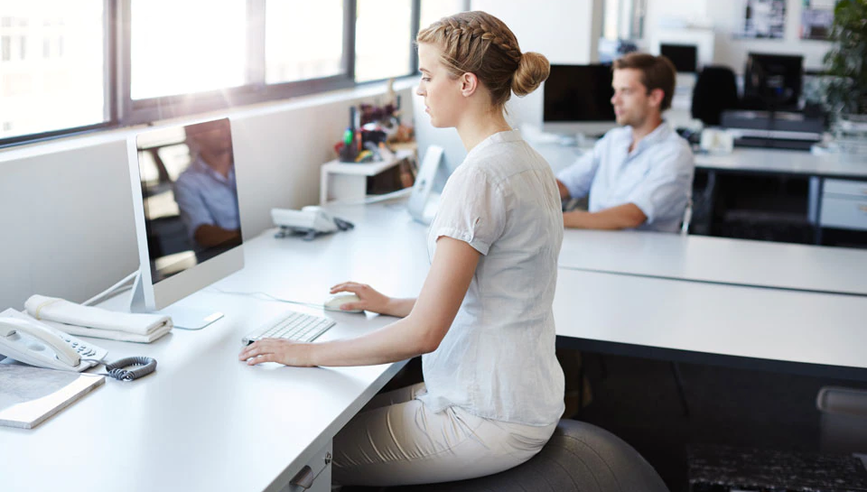Ergonomics in the Modern Office


Exercise balls and standing desks are just a few examples of new workplace trends being spotted in many modern offices. While examples like these are favored by some for promoting informal group collaboration and by others for their perceived health benefits, both have the potential to cause discomfort or injuries. So before trading in the traditional desk chair for a hipper alternative, it is important to understand the possible risks you may be facing, and how those risks relate to office ergonomics and your comfort.
Exercise Balls: Lack of Back Support a Concern
Exercise balls have been a frequent fixture in fitness and physical therapy programs over the past decades, used in exercises and rehabilitation programs to target specific muscle groups. Sitting on an exercise ball without back support can result in constant back movement, which is believed to activate the back muscles and to help maintain muscle tone.
However, while there have been studies around the fitness and therapy benefits of using exercise balls, there is little research to support the use of exercise balls as chairs in an office setting for extended periods of time. Using an exercise ball as a chair provides no back support and leads the back muscles to contract, causing compression of discs in the back. According to a study conducted by Cornell University, while the use of an exercise ball may help with some core strengthening, it fails to provide back support and should not be used as a replacement for a good ergonomic office chair.1 Placing an exercise ball in a frame with legs may address some safety concerns, but still does not support the lower back region when seated.2
What to Look for in an Office Chair
According to Travelers Risk Control ergonomics professionals, proper seating provides the following features, which exercise balls lack:
- A pneumatic height adjustment.
- A height adjustable lumbar support.
- A seat back which can either be locked in an upright position or inclined up to 110 degrees.
- Adjustable padded armrests with rounded edges.
- An adjustable seat pan.
- A five caster base with appropriate casters for the flooring surface.
Standing Desks: A Good or Bad Idea?
News headlines continue to cite the health risks of sitting for prolonged periods of time, and a sedentary lifestyle in general. According to the National Institutes of Health, sedentary behavior is linked to a shorter lifespan and a wide variety of medical problems.3 Standing desks have been growing in popularity as an alternative to eight hours spent sitting. But are they really all they are cracked up to be?
In fact, standing desks can present their own health risks. According to Travelers Risk Control ergonomics professionals, there is an increased risk of injury if a worker spends a prolonged period of time working at an improperly designed workstation. For example, if a workstation is too high, it leads to raised elbows, and if it is too low, it leads to stooped back posture. Other potential ergonomic problems include unsupported back or legs, leaning and reaching. Static postures, a hard floor or poor shoes can also contribute to potential discomfort and injury. Prolonged standing also becomes a risk, as it is linked to reduced circulation and discomfort in the feet, as well as in the lower back.
Designing Standing Desks for Comfort
If you are considering including a sit-stand desk in your office, make sure the desk accommodates the employee’s work height for both sitting and standing. Training should also be provided for sit-stand desks to educate users on neutral postures, appropriate footwear and the risk factors associated with both static sitting and standing postures.
Whether sitting or standing, the goal is to help the employee work at a neutral posture:
- The work should be at elbow height.
- The shoulders are relaxed, with the arms near the side.
- Wrists are straight.
- Head is straight.
- Weight is balanced.
Consider providing an anti-fatigue mat for the floor or encourage employees to wear shoe insoles for prolonged standing. Employees should change their posture by occasionally sitting or walking if using a standing workstation.
According to Travelers Risk Control, users who cannot sit for more than 30 minutes or whose job duties do not allow for movement away from their desks or a change in posture could be considered for a sit-stand desk. Users who have no medical need, are able to work with neutral postures at their workstation and are capable of moving away from their workstation may benefit less from a sit-stand desk.
For more on ergonomics: Are you doing everything you can to help your employees feel comfortable at work? Learn tips on how to adjust a desk chair and workstation.
Sources
1 http://ergo.human.cornell.edu/cuBallChairs.html
2 Using an Exercise Ball as an Office Chair: Risks to Human Anatomy, Travelers Risk Control position paper.
3 https://newsinhealth.nih.gov/issue/dec2012/feature1



